The 1958 Voice of America (VOA) and U.S. Information Agency (USIA) promotional pamphlet seems to have been written primarily for Americans although it was also designed for distribution overseas. In a simple and somewhat patronizing language, the pamphlet conveys the message that the Voice of America provides foreign audiences with a full and accurate presentation of U.S. government official statements and policies and that it counters “the distortions of hostile propaganda” from communist-ruled nations.
Thus, the Voice of America carries out its function as the radio arm of the U. S. Information Agency. The Agency uses all methods of communication in the Free World to carry out the President’s instructions that it inform “all peoples throughout the world” of the policies and objectives of the U. S. Government and that it counter the distortions of hostile propaganda.
The pamphlet also made it clear that most of VOA’s broadcasters are U.S. citizens.
Many of these language experts were born abroad, some are fugitives from communism, others originally came to the United States to study or to teach. Except in a few cases where no American could be found who had the necessary language skill, all of these people are American citizens.
The VOA and USIA 1958 promotional pamphlet mentioned communist jamming of Voice of America broadcasts.
THE Communists, to prevent the truth from reaching their people, constantly attempt to “jam” the programs beamed to Russia and the Soviet-controlled areas. In fact, it is estimated that they spend more money to black out Western broadcasts than is spent on the Voice’s entire worldwide broadcasting operation.
But the pamphlet also pointed out that VOA broadcasts to communist-ruled countries were reaching their audiences despite of jamming.
That broadcasts are heard in spite of jamming is clear from the mail received from Communist-area listeners, from interviews with escapees, from violent attacks on the Voice by the Communist press and from reports from United States missions, correspondents and travelers.
the
VOICE OF AMERICA
broadcasts….
- IN 43 LANGUAGES
- OVER A NETWORK OF 85 TRANSMITTERS
- AROUND THE CLOCK
- AROUND THE GLOBE
U.S. INFORMATION AGENCY
WASHINGTON, D.C.
The VOICE OF AMERICA speaks
in many languages
THE
VOICE OF AMERICA
Voice of America went on the air for the first time on February 24, 1942, speaking for the Government of the United States to the German people, who were then cut off from the world by Nazi censorship.
That broadcast originated in New York in an improvised studio so small that only one person at a time could get in to speak over the microphone.
Today, from 18 specially designed studios and other modern facilities in Washington, the Voice broadcasts around the clock and around the globe in 43 languages. Its more than 75 daily programs go through a network of 85 transmitters.
Thus, the Voice of America carries out its function as the radio arm of the U.S. Information Agency. The Agency uses all methods of communication in the Free World to carry out the President’s instructions that it inform “all peoples throughout the world” of the policies and objectives of the U. S. Government and that it counter the distortions of hostile propaganda.
But in Communist controlled areas the Information Agency cannot show films, provide press or TV materials or run libraries and information centers. In this restricted section of the world, the United States must rely upon the Voice of America to convey the truth about world events and American policies.
Consequently, three-fourths of the Voice’s direct, shortwave broadcasts are beamed to the Soviet Union, the Eastern European satellites, Red China, North Korea and North Vietnam. (See chart on inside back cover for geographic distribution of broadcasts.)
PEOPLE AT THE VOICE
To overseas listeners, the Voice of America means the announcers and commentators who speak to them regularly in their own tongue.
Behind these familiar voices are experienced writers, editors, engineers and technicians drawn from this country’s leading radio stations and networks and from colleges and universities.
Indispensable to the Voice’s operation, however, are the linguists and the experts on the customs and culture of other lands who enable the Voice to speak effectively for this country to distant lands.
Many of these language experts were born abroad, some are fugitives from communism, others originally came to the United States to study or to teach. Except in a few cases where no American could be found who had the necessary language skill, all of these people are American citizens.
A former princess, a direct descendant of the king in “Anna and the King of Siam,” regularly broadcasts news and commentary in the Thai language to her native land.
A professional man who brought his wife and children out of China to escape life under the Communist regime speaks daily to Chinese listeners in one of the three Chinese dialects of the Voice.
A former actress from Prague now translates news material and announces programs beamed to Czechoslovakia.
A native of Jerusalem, formerly a foreign broadcasting correspondent in the Arab world, is in charge of the Voice’s Arabic programs.
These are among the daily spokesmen of the Voice.
Speakers on special broadcasts include the President, the Secretary of State, Members of Congress and many other prominent figures. Also heard frequently are visitors to this country—govern ment officials, students, scientists, artists, businessmen—speaking to their homelands about the United States, its people and its way of life as they are seeing it.
SHORTWAVE PROGRAMS
THE Voice produces about 40 hours of direct shortwave broadcasts each day and these programs, directed behind the Curtains, are repeated an additional 85 hours to give listeners a choice of time and to counteract Soviet jamming efforts.
All broadcasts include a straight, factual report of the news, with emphasis on matters of particular interest in the area where the program is heard. Important happenings in the United States, de velopments in the United Nations (reported by direct wire from the UN building), on-the-spot reports from international conferences and news of all nations in the Free World are included in the broadcasts. So are events in the Soviet Union, Red China and the Communist satellites. Behind-the-curtain listeners often learn the truth about economic developments and political changes in their own country from Voice broadcasts before getting highly censored and slanted official announcements from the Communist-controlled press and radio.
Vice President Nixon, on goodwill tour, speaks to world wide audience over Voice of America microphone.
The Voice’s own reporters and commentators supplement the daily files of the world’s major news-gathering agencies to provide this flow of news to the Information Agency’s radio audience.
News commentaries and features also are used on Voice broad casts. The official position of the United States Government is made crystal clear in the daily Voice commentaries. A weekly review of United States policy, in the voices of the President, the Secretary of State and other cabinet members, gives emphasis to the official character of the broadcasts. When appropriate, the commentaries set the record straight by unmasking and countering hostile attempts to frustrate and misrepresent the objectives and motives of the United States.
Commentaries also include discussions of economic conditions in the United States and the Free World and facts about labor and agriculture. Each language service carries religious programs on Sunday and on denominational holidays and also provides its listeners with a picture of the United States and its people through programs on community life and various aspects of American culture. Special emphasis is given to such timely subjects as the development of peaceful uses of atomic power and the President’s “Summit” proposal for mutual inspection as the first step toward disarmament.
The open and free discussion of world events in the United States is demonstrated in summaries of American press, radio and television opinion and through the broadcast of roundtable discus sions by distinguished personalities.
Audience-building techniques used successfully by commercial broadcasters in the United States have also been incorporated in the Voice’s daily program schedule. An instance of this is a i-hour English language program, called “Panorama-USA” and consisting of music, features and news, beamed daily to Europe.
Technicians “presetting” master control panel, which can handle 26 transmitters at once, switching all channels at every program break.
The VOA Around the World and Around the Clock.
THE VOICE NETWORK
THE Voice network of 85 transmitters includes 30 shortwave stations in the United States. The 55 overseas transmitters are located to get maximum penetration into the Communist world. Three of them, in Germany, the Philippines and Okinawa, have million-watt output power and are the world’s most powerful broadcasting facilities.
The network also includes a floating broadcasting station, the United States Coast Guard Cutter Courier, now relaying broadcasts daily to the Communist world and free nations in the Near East from its anchorage off the Island of Rhodes in the Mediterranean Sea. This seagoing vessel was especially equipped to provide the Voice with a flexible relay station to meet any emergency situation.
The Voice’s headquarters are located in Washington, D. C., the originating point for most of the daily programs. A radio center is also maintained in Germany, and regional centers are located in France, Egypt and the Philippine Islands.
The Coast Guard cutter Courier uses this antenna and both medium and shortwave transmitters to beam Voice of America broadcasts to Soviet Orbit from vessel’s berth off Island of Rhodes.
LISTENERS IN COMMUNIST AREAS
THE Communists, to prevent the truth from reaching their people, constantly attempt to “jam” the programs beamed to Russia and the Soviet-controlled areas. In fact, it is estimated that they spend more money to black out Western broadcasts than is spent on the Voice’s entire worldwide broadcasting operation.
The Voice’s network of transmitters, particularly the million watt installations, and its system of repeating broadcasts at different times and on many frequencies are two of the methods of penetrating the jamming screen.
That broadcasts are heard in spite of jamming is clear from the mail received from Communist-area listeners, from interviews with escapees, from violent attacks on the Voice by the Communist press and from reports from United States missions, correspondents and travelers.
A refugee from Communist China reported in Hong Kong: “Men risk their lives to listen to the Voice of America, hoping to hear from outside the Bamboo Curtain.”
Stephan Rabovsky and wife, Nora Kovach, Hungarian ballet stars who Fled to the Free World, speak from Washington to Voice listeners in Hungary.
A Rumanian exile spoke of the Voice as our daily bread and daily support to endure life.”
Two of Hungary’s top ballet performers said after their escape to the West: “The Russians themselves listen to the Voice of America. In Moscow and Leningrad we heard people talk about news which they could only have learned from the Russian language broadcasts. We knew it very well for we had followed the same items in the Voice’s Hungarian program.”
Numerous Americans who have visited the Soviet Union since 1955 have brought back encouraging reports about the extent to which Voice programs are heard by people in Soviet territory.
PROGRAMS FOR LOCAL STATIONS
BY working closely with foreign radio networks and stations in the Free World, the Voice reaches the large numbers of people who customarily tune in on their local stations. In some areas, direct “feeds” are supplied these local stations from the United States with news programs and coverage of special events. In other areas, local stations regularly receive “package programs,” consisting of features, music, special events, interviews and commentaries.
In Latin America and Western Europe, for instance, all for eign language programs produced by the Voice are aired through the cooperation of local stations and networks. In the Near East and Far East, local stations are carrying an increasingly large amount of material prepared for their special use by the Voice staff.
WASHINGTON STUDIOS
THE Washington facilities of the Voice include 18 studios, ten rooms equipped to make 40 discs or tape recordings simultaneously, ten tape-editing booths, a recording control center, the Master Control, editorial offices and music and transcription libraries.
The Master Control is the largest and most flexible in the world. It feeds the programs through telephone lines to the short wave transmitters in the United States. The Control Console is capable of selecting program material from 100 sources and handling 26 programs simultaneously.
Indonesian language staff preparing to go on the air with daily broadcast.
TELEVISION
WITH the advent of television in many foreign countries, the Agency began to supply TV material in quantity for overseas use, so that increasing numbers of people overseas could see, as well as hear, the truth about this country, its people and aims.
Expansion of the output of television programs by the Agency is keeping pace with the rapidly increasing number of stations and set owners in many parts of the world.
USIA television material includes newsreels, special events, policy statements by United States Government officials, adaptations of programs used on television in the United States and original productions dealing with basic. American policies and activities.
U. S. Information Agency films television production for use overseas.
PUBLIC TOURS
VOICE OF AMERICA STUDIOS
Monday through Friday, 11 a. m. and 3 p. m.
Second Floor, Health, Education, and Welfare Building
330 Independence Avenue, SW.
Washington, D. C.


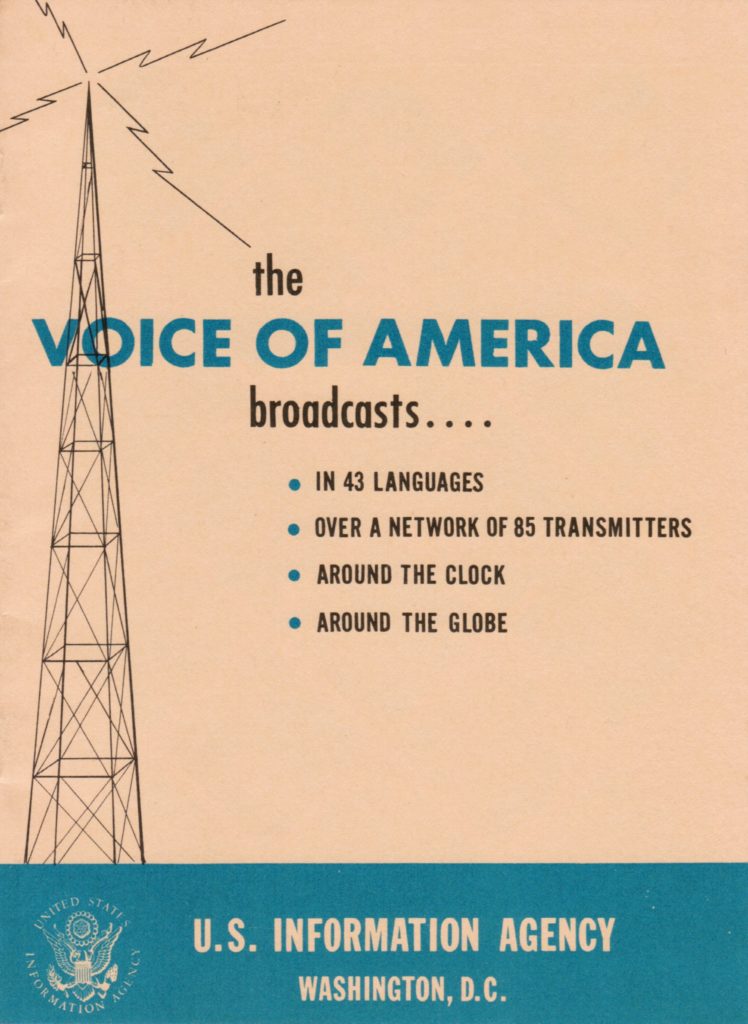

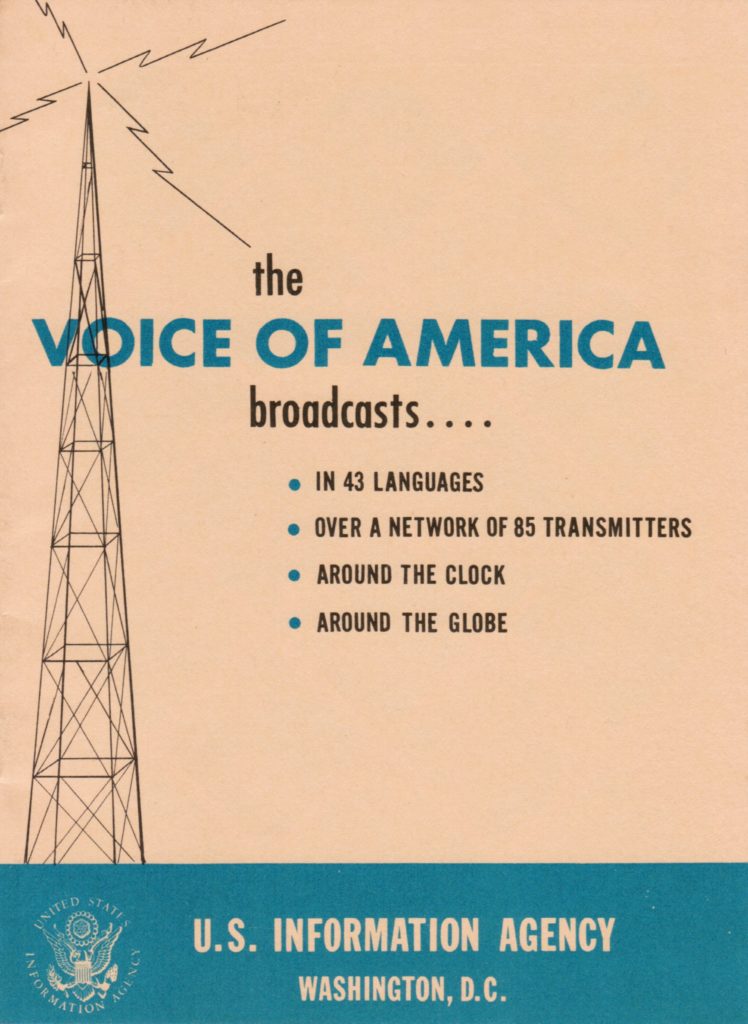
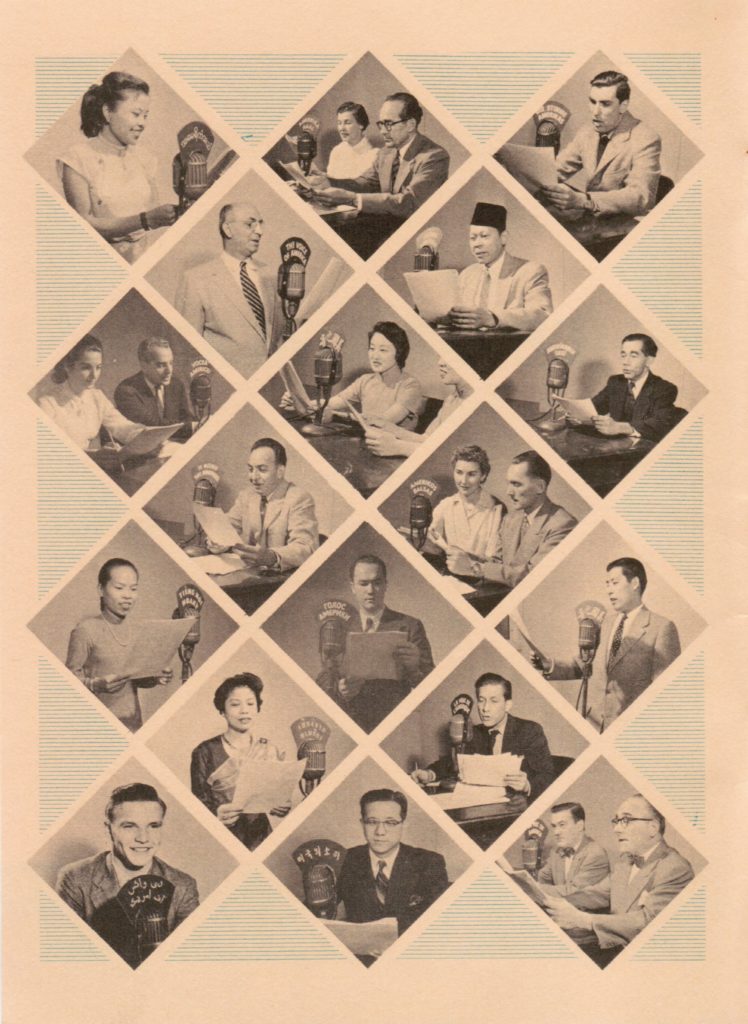
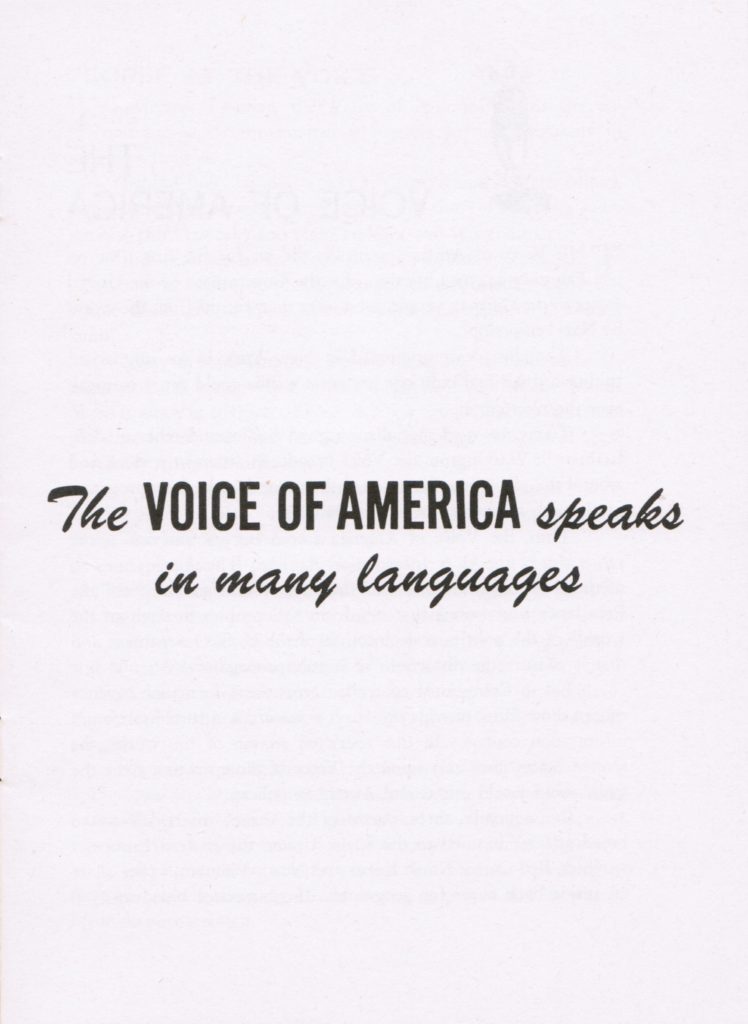
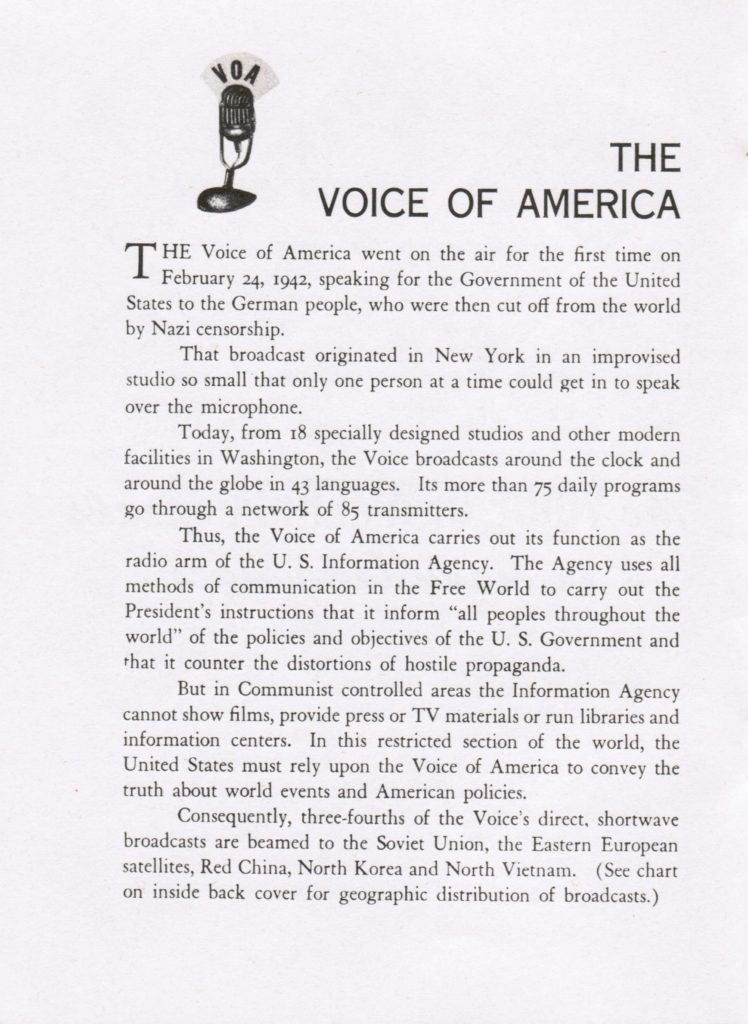
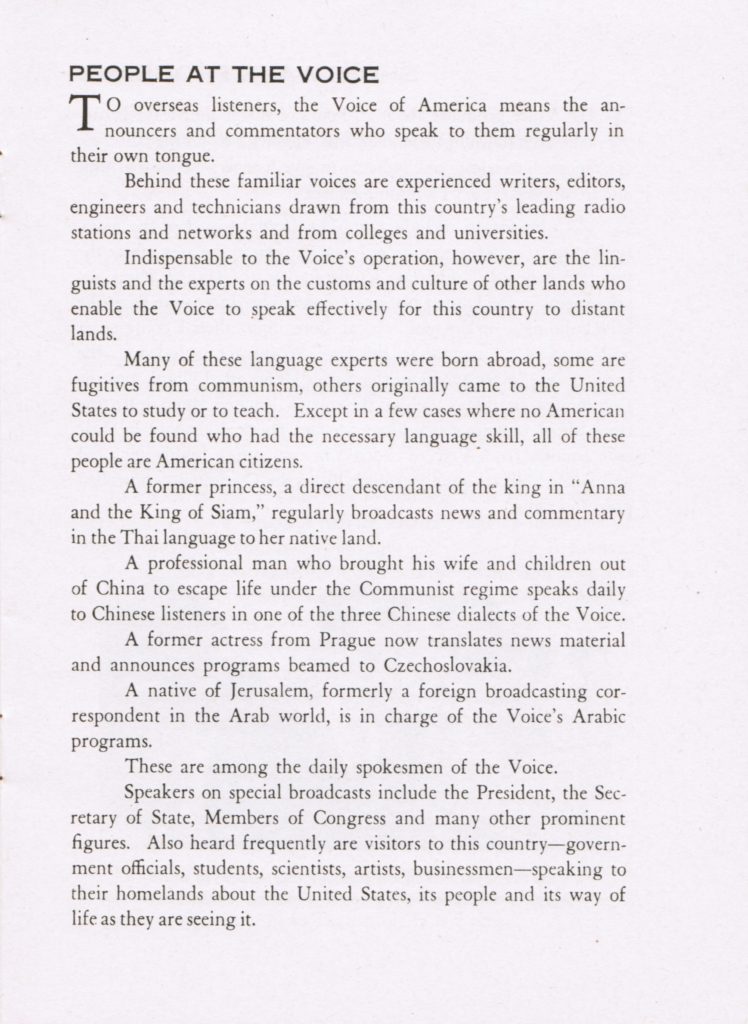
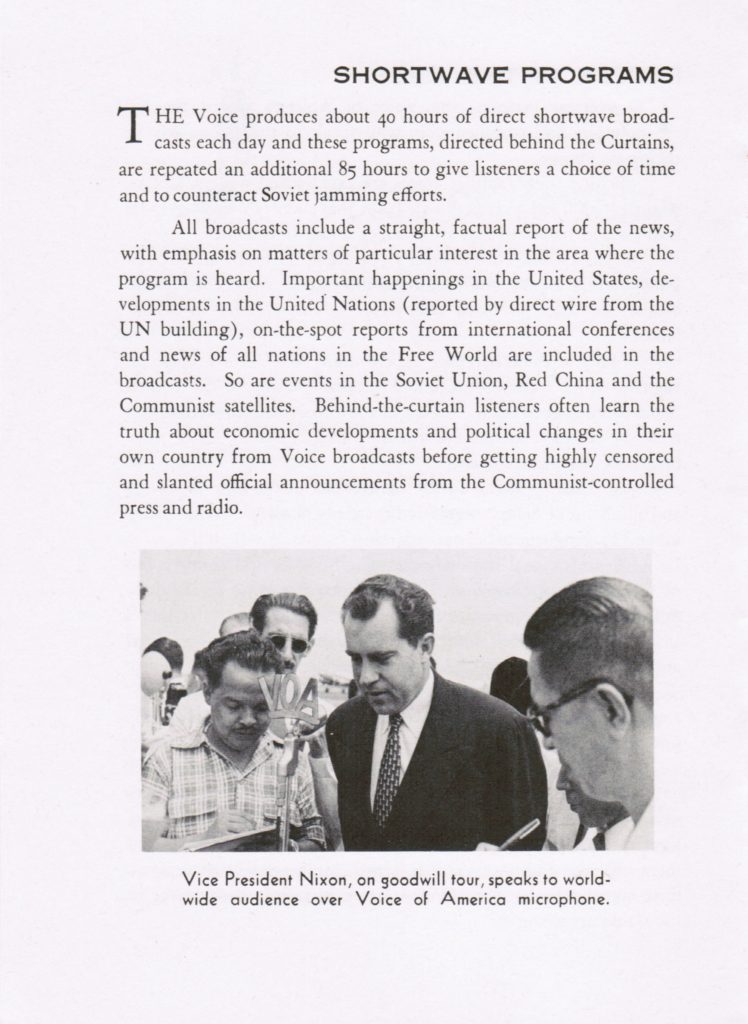
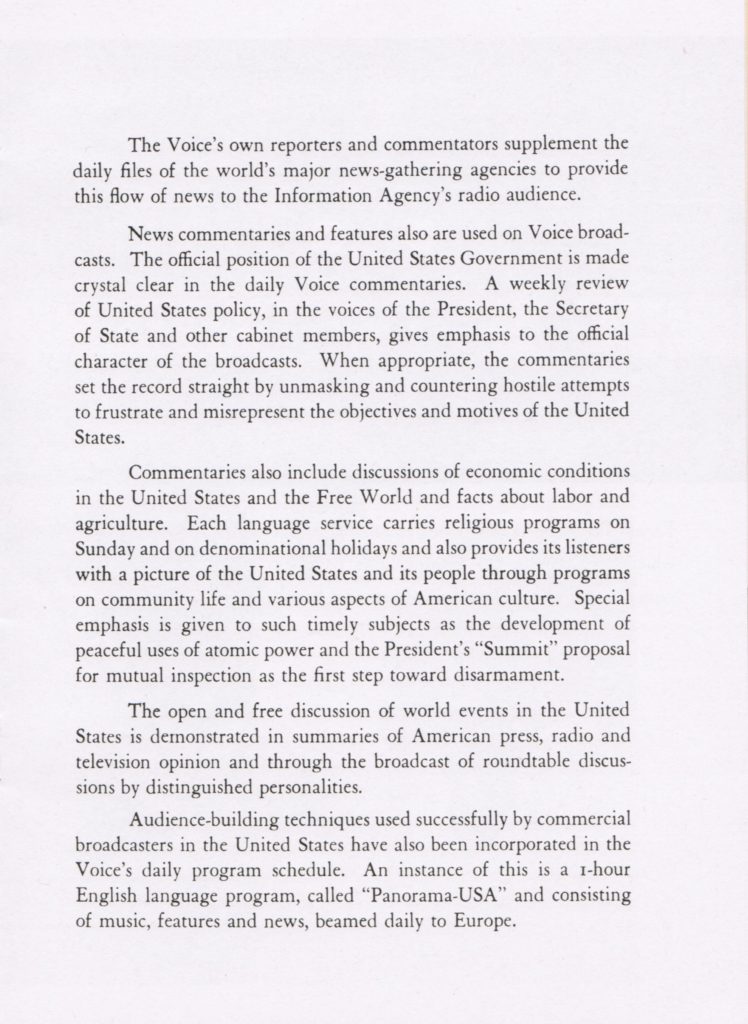
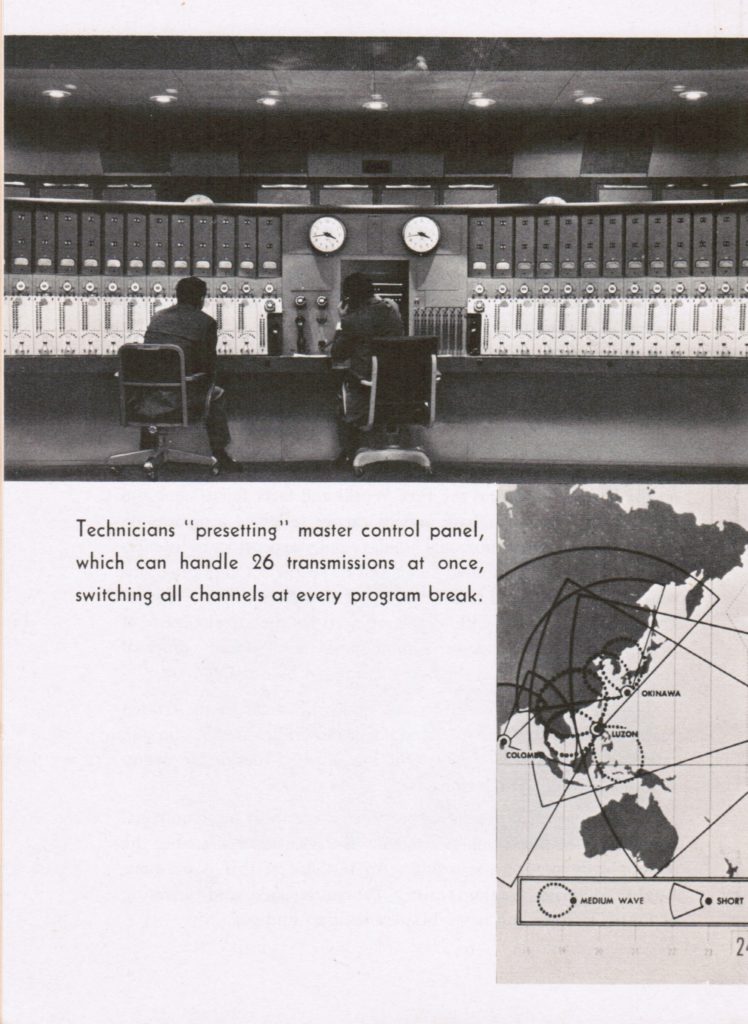
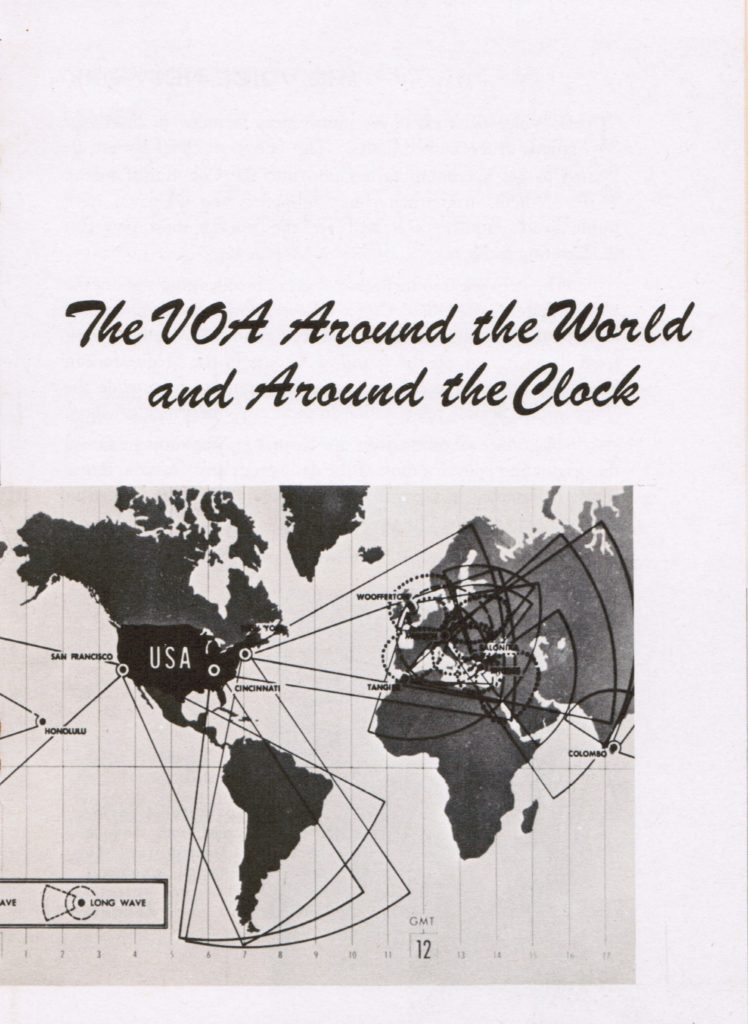
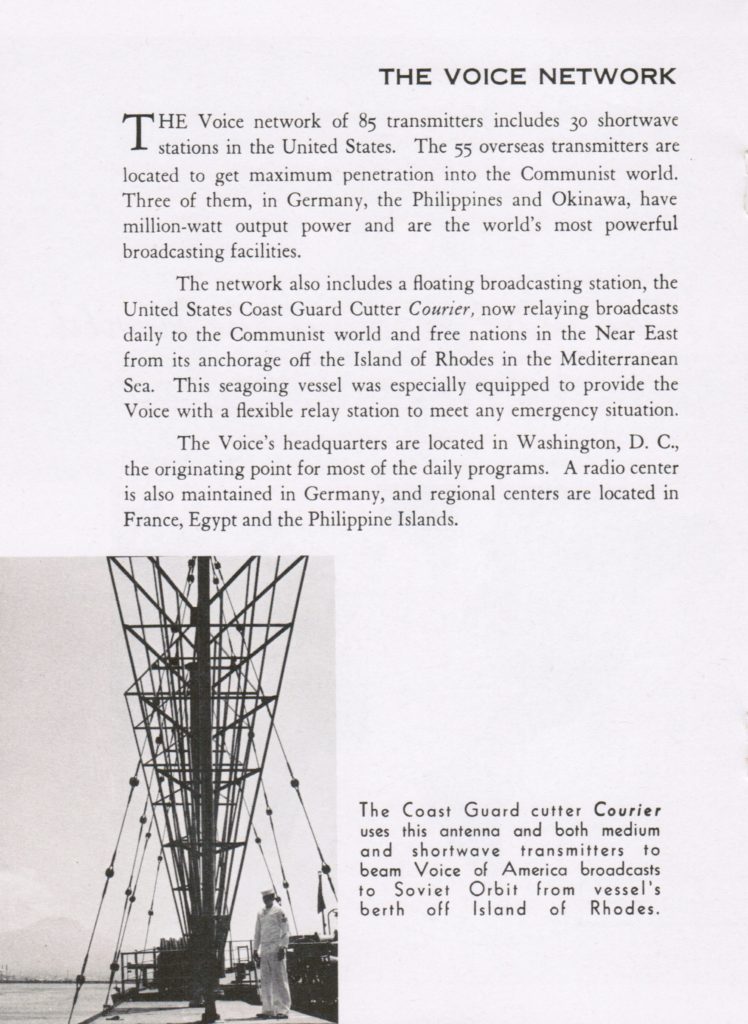
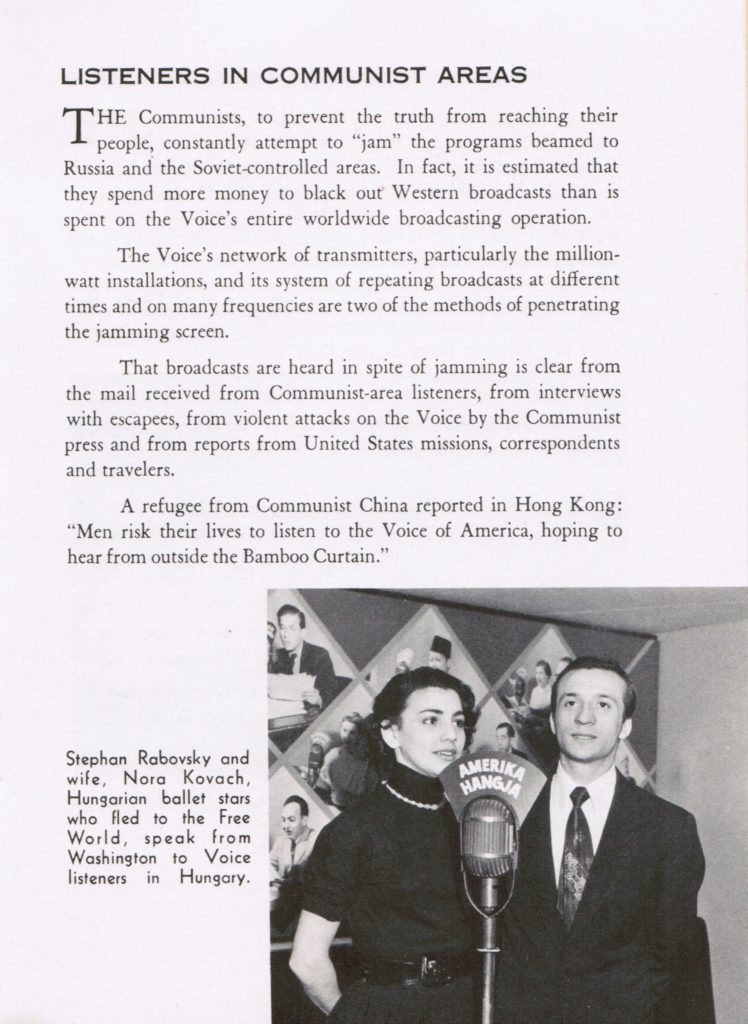
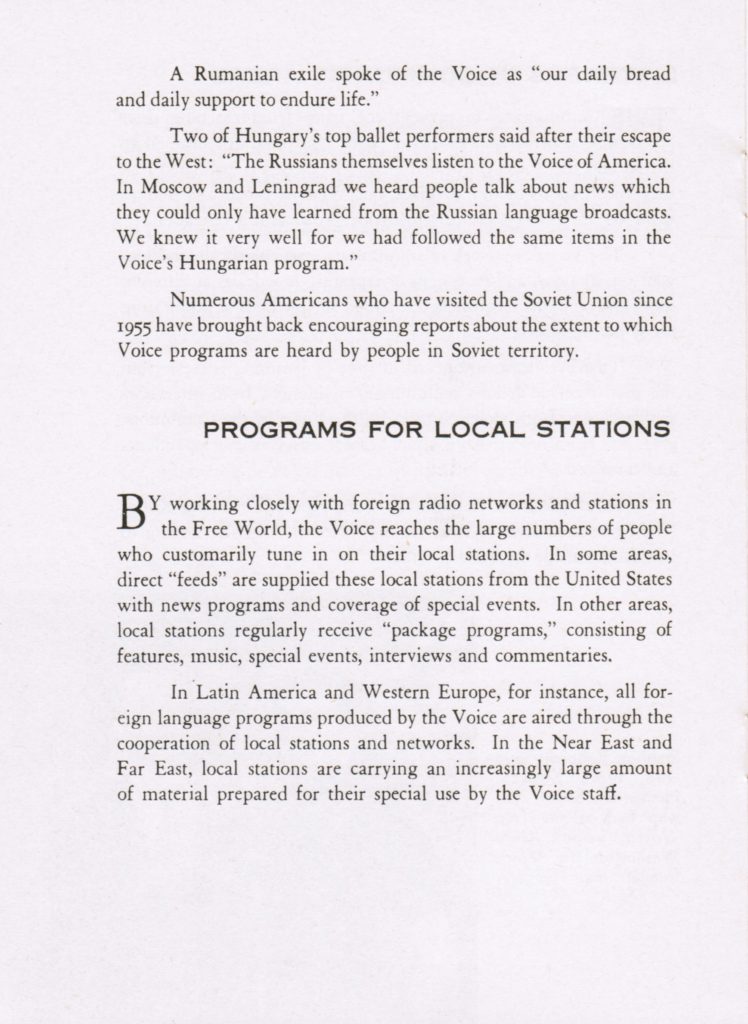
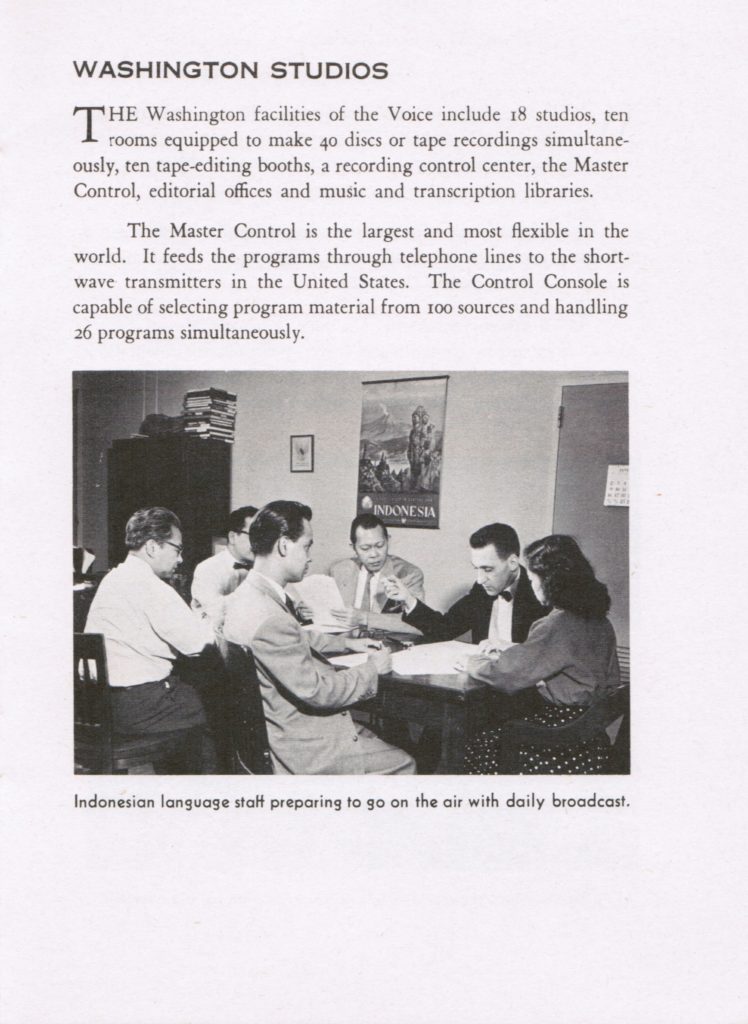
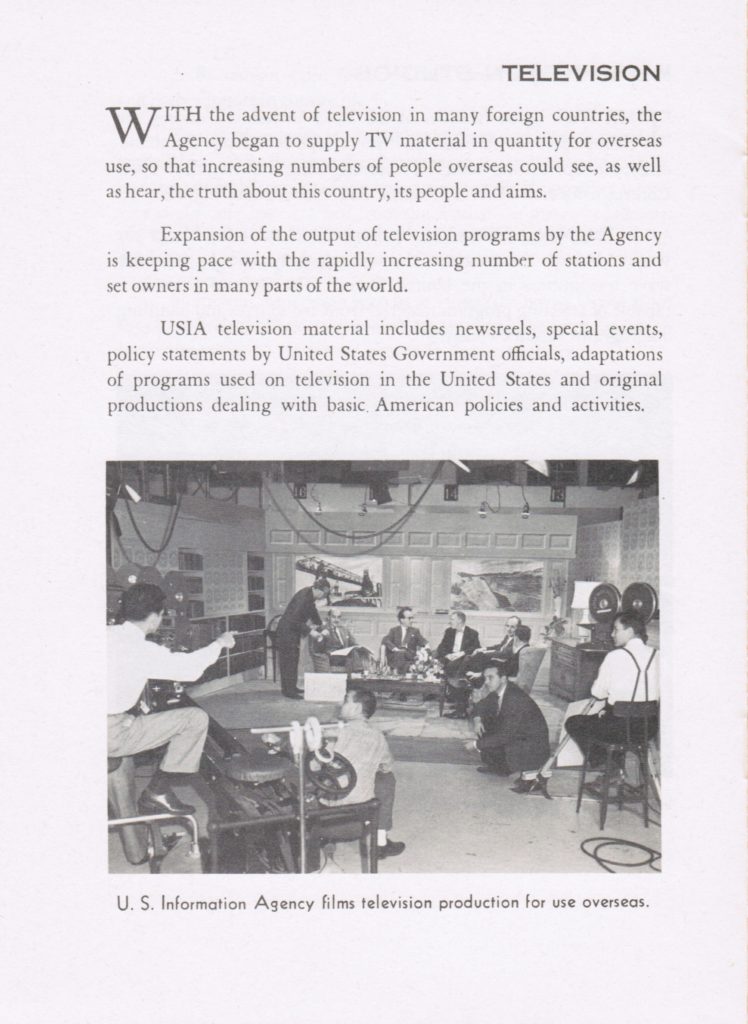
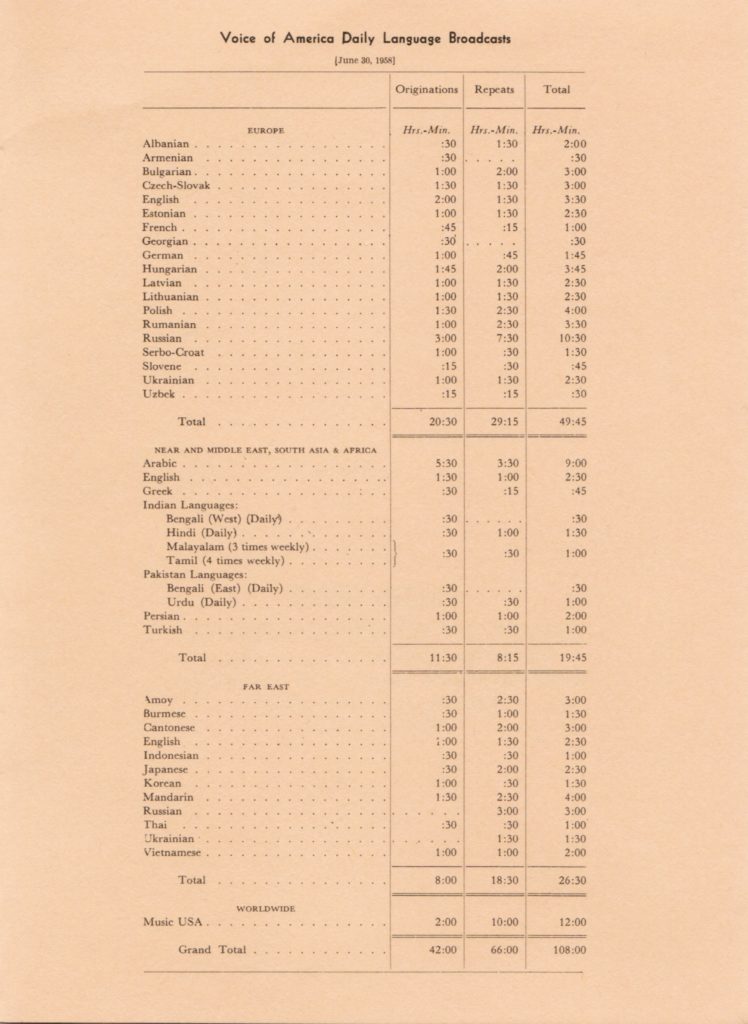
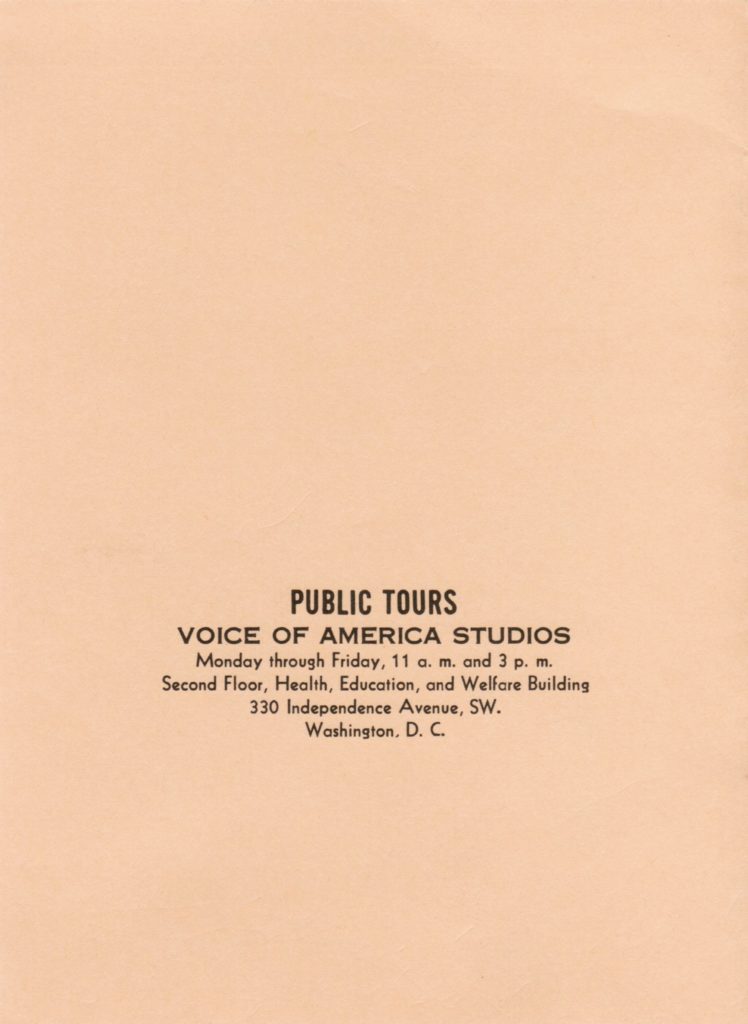
Add Comment